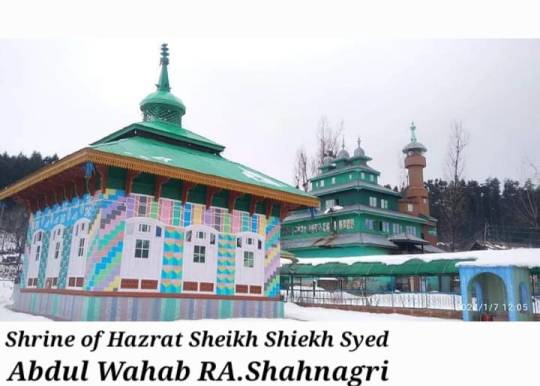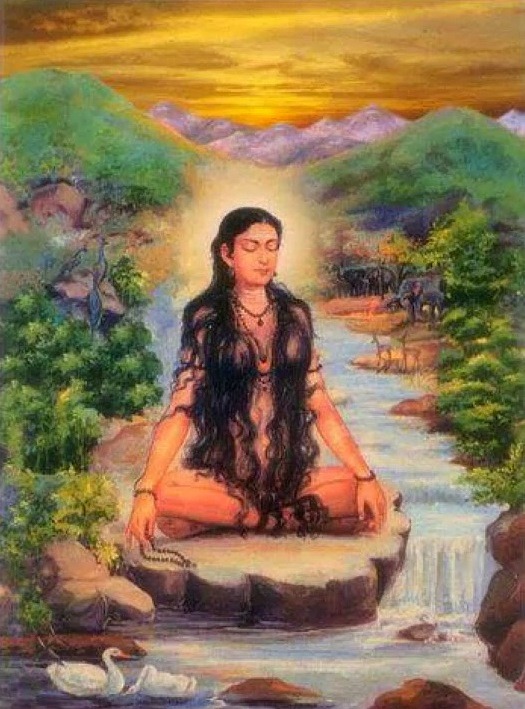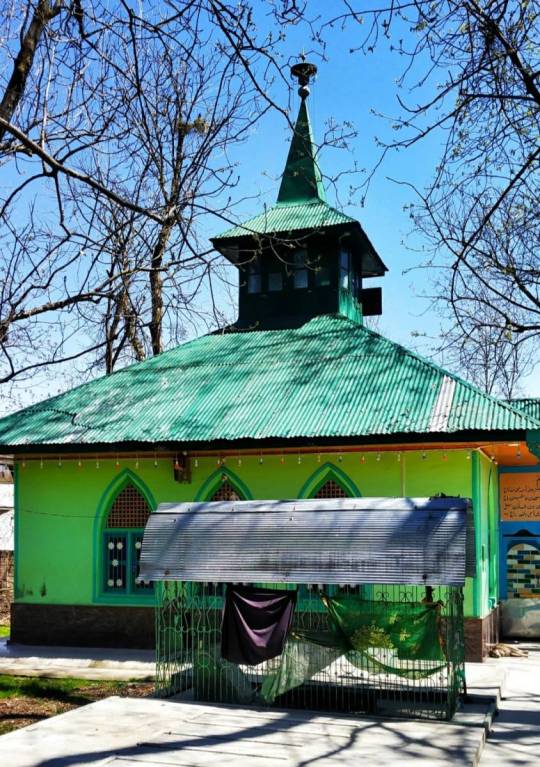#spirituality of kashmir
Text
Kupwara: An abode of Sufi Saints-Khursheed Dar (Pohrupeth langate)
Kupwara is among those few districts of Jammu and Kashmir that are blessed in many ways. Apart from the sheer natural beauty that Kupwara district possesses, the district also has a rich heritage and culture. The diversity that this district possesses in the form of various tourist sites, pertaining to different facets of history, religion, and culture is phenomenal. One aspect of this diversity…

View On WordPress
#army of God#chishti#kashmiri spiritual circle#kashmiri sufism#kupwara shrines#naqshbandi#owaisi#Qadiri#qubravi#Quran#saints of kashmir#shadhili#shazili#shorawardi#shrine of kashmir#shrine of kupwara kashmir#soharwardi#spiritual persons in kashmir#spirituality in kashmir#spirituality of kashmir#true Sufis#who are sufis
0 notes
Text
Intro to Tantric Shaivism: II - Kashmiri Shaivism
In my previous write-ups I explained what Tantra is and gave a brief introduction to Tantric Shaivism. In this write-up I’ll continue my exploration of Tantric Shaivism by introducing one of the most sophisticated traditions of Tantric Shaivism: Kashmiri Shaivism. I won’t talk about the sages who inspired these schools as I think that will make the essay way too long but instead focus on the main philosophy of each school within Kashmiri Shaivism. The three main active schools of thought within Tantric Shaivism today are Kashmiri Shaivism, Saiva siddhanta and Aghori.
Kashmiri Shaivism is also known as the Trika system. It is a monistic tradition but cannot be defined as one school of thought but rather a collective of different schools that originated in Kashmir, namely: Pratyabhijna, Kula, Spanda, and Krama schools.
It is known as the Trika system because they believe that the world contains three energies:
Para (transcendental) - para
Parapara (subtle) - sukshma
Apara (gross) - sthula
The right hand side of the names: sthula, sukshma and para are the names of these energies in the saiva siddhanta tradition.
Pratyabhijna
The word pratyabhijna means “to spontaneously once again recognize and realize your Self.” Here you have only to realize, you do not have to practice. There are no upayas (means) in the Pratyabhijna system. You must simply recognize who you are. This teaching, therefore, is situated chiefly in anupaya, which is that means where there are no means at all. It is the recognition that there was nothing to be done and nowhere to go. Here, there is no practice, no concentration and no meditation.
The purpose of Pratyabhijñā is the recognition of the Śiva nature of the world (and oneself). In order to achieve that, it is necessary to induce a modified state of consciousness through the use of Śakti. Śakti, loosely translated as energy, is the dynamic aspect of Śiva, the link between finite (the human subject) and infinite (Śiva). Thus comes about the fundamental principle: "Without the help of Śakti, pratyabhijñā is impossible”.
2. Kula
Abhinavagupta, one of the main Sages of this tradition, tells us that the term Kula is derivable from the root kul, which can mean a grouping together. From this meaning we can derive one of the meanings of Kula, a human grouping, namely a family, or more specifically a spiritual family that extends as far back as Siva himself. This lineage is unified by the sequential transmission of the achieved vision of the ultimate.
The Kula system teaches you how you can live in caitanya (universal Consciousness), the real nature of yourself, in the act of ascending and descending. While you rise from the lowest to the highest you realize your nature, and while you descend from the highest to the lowest you also realize your nature.
The difference between the Pratyabhijna system and the Kula system is, that the Pratyabhijna system teaches you how to realize your own nature in one place and exist there, reside there. While the Kula system teaches you how you can rise from the lowest degree to the highest degree, and all the while, experience the nature of your Self on the same level and state. Shiva, which is realized in prithvi tattva (earth element), is the same level, the same reality of Shiva which is realized in Shiva tattva. Here, there is complete realization in every act of the world.
3. Spanda
The word spanda means “movement.” The Spanda school recognizes that nothing can exist without movement. Where there is movement there is life, and where there is no movement that is lifelessness. Spanda is the vibration or the pulse of consciousness. Every activity in the universe, as well as every perception, notion, sensation or emotion in the microcosm, ebbs and flows as part of the universal rhythm of the one reality, which is Siva ,the one God who is the pure conscious agent and perceiver.
According to the Doctrine of Vibration, man can realise his true nature to be Siva by experiencing Spanda, the dynamic, recurrent and creative activity of the absolute. It is Spanda, the inscrutable pulse of consciousness, that moves and yet moves not, that changes and yet remains eternally itself, that ensures~that both manifestation and the absolute, its unmanifest source, form part of a single process which passes freely from one to the other in such a way that both poles are the same level and equally real.
The difference between the Pratyabhijna school and Spanda are that the spanda school emphasises on the recognition and experience of the vibration of consciousness while the former emphasises direct experience of Siva as oneself.
4. Krama
Krama system shows the development of Saktha tendencies in Saiva philosophy. Based on the Kālīkula (Kālī worship) branch of Tantric Śaivism, Krama means (‘sequence’) which internalized ritual worship of goddesses as the cyclical phases (krama) of one’s own awareness. The Krama system moves in space and time, but finally leads to Paramaśiva, who is beyond space and time.
Ritual came to be understood as an inner process of realisation through which the initiate discovered his/her essential identity with Kali, who is the flow (krama) of the power of consciousness through the polarities of subject, object and means of knowledge in consonance with their arising and falling away in each act of perception.
The experience of this process coupled with the arousing of man's spiritual potential (kundalini) and the expansion of consciousness that brings it about is the most esoteric practice of the Krama system of Kashmiri Saivism.
Kashmir Shaivism shares many parallel points of agreement with the lesser known monistic school of Shaiva Siddhanta as expressed in the Tirumantiram of Tirumular. This is a very brief introduction to the different schools of thought within Kashmiri Shaivism. It is important to recognise that these philosophies draw on each other as inspiration for their practices and contain less hard drawn lines. In the next piece I’ll talk about Saiva siddhanta.
P.S. As usual if you want the links to the resources I referenced, more than happy to send them your way.
#hinduism#hindu gods#religion#theology#tantra#spirituality#hindublr#lord shiva#shiva#desiblr#kashmir#kashmiri pandits
31 notes
·
View notes
Text
This dua is very popular in Kashmir especially during Fajr prayers.
ﺍﮮ ﺧﺎﻟﻖ ﮨﺮ ﺑﻠﻨﺪﯼ ﻭ ﭘﺴﺘﯽ
ﺷﺶ ﭼﯿﺰ ﻋﻄﺎ ﺑﮑﻦ ﺯ ﮨﺴﺘﯽ
ﺍﯾﻤﺎﻥ ﻭ ﺍﻣﺎﻥ ﺗﻨﺪﺭﺳﺘﯽ
ﻋﻠﻢ ﻭ ﻋﻤﻞ ﻓﺮﺍغ ﺩﺳﺘﯽ
"Oh the creator of every high and low of the world
Grant me six favours from your grace
Faith, Contentment and Strength
Knowledge, Practicality and Prosperity"

#islam#islamic#muslim#quran#kashmir#free palestine#free gaza#ramadan#prophet muhammad#islampost#healthcare#health & fitness#faith#belief in god#allah#allahuakbar#spirituality#spirtualgrowth
23 notes
·
View notes
Text
Selections from the Mystic Poetry of Lalla of Kashmir
Restless mind, don’t infect the heart with fear.
That virus is not for you.
The Infinite knows what you hunger for.
Ask Him to carry you across.
Some, who have closed their eyes, are wide awake.
Some, who look out at the world, are fast asleep.
Some who bathe in sacred pools remain dirty.
Some are at home in the world but keep their hands clean.
Good or bad, I’m happy to welcome both.
I don’t hear with my ears, I don’t see with my eyes.
A voice speaks inside my heart,
my jewel-lamp burns bright even in a rampaging wind.
Lord! I’ve never known who I really am, or You.
I threw my love away on this lousy carcass
and never figured it out: You’re me, I’m You.
All I ever did was doubt: Who am I? Who are You?
Wrapped up in Yourself, You hid from me.
All day I looked for You
and when I found You hiding inside me,
I ran wild, playing now me, now You.
Don’t flail about like a man wearing a blindfold.
Believe me, He’s in here.
Come in and see for yourself.
You’ll stop hunting for Him all over.
A thousand times at least I asked my Guru
to give Nothingness a name.
Then I gave up. What name can you give
to the source from which all names have sprung?
Who trusts his Master’s word
and controls the mind-horse
with the reins of wisdom,
he shall not die, he shall not be killed.
Those who glow with the light of the Self
are freed from life even while they live.
But fools add knots by the hundred
to the tangled net of the world.
When the dirt was wiped away from my mind’s mirror,
people knew me for a lover of God.
When I saw Him there, so close to me,
He was All, I was nothing.
I trapped my breath in the bellows of my throat:
a lamp blazed up inside, showed me who I really was.
I crossed the darkness holding fast to that lamp,
scattering its light-seeds around me as I went.
Alone, I crossed the Field of Emptiness,
dropping my reason and my senses.
I stumbled on my own secret there
and flowered, a lotus rising from a marsh.
My mind boomed with the sound of Om,
my body was a burning coal.
Six roads brought me to a seventh,
that’s how Lalla reached the Field of Light.
You rule the earth, breathe life
into the five elements.
All creation throbs with the Unstruck Sound.
Immeasurable, who can take Your measure?
He who strikes the Unstruck Sound,
calls space his body and emptiness his home,
who has neither name nor colour nor family nor form,
who, meditating on Himself, is both Source and Sound,
is the god who shall mount and ride this horse.
He knows the crown is the temple of Self.
His breath is deepened by the Unstruck Sound.
He has freed himself from the prison of delusion.
He knows he is God, who shall He worship?
Master, leave these palm leaves and birch barks
to parrots who recite the name of God in a cage.
Good luck, I say, to those who think they’ve read the scriptures.
The greatest scripture is the one that’s playing in my head.
What the books taught me, I’ve practiced.
What they didn’t teach me, I’ve taught myself.
I’ve gone into the forest and wrestled with the lion.
I didn’t get this far by teaching one thing and
doing another.
I gave myself to Him, body and soul,
became a bell that the clear note of Him rang through.
Thoughts fixed on Him, I flew through the sky
and unlocked the mysteries of heaven and hell.
Wear the robe of wisdom,
brand Lalla’s words on your heart,
lose yourself in the soul’s light,
you too shall be free.
-- I, LALLA
The Poems of Lal Ded
Translated from the Kashmiri
by Ranjit Hoskote

#lalla#kashmir#kashmir shaivism#communion with God#meditation#spirituality#mystics#poetry#sants#sufis
33 notes
·
View notes
Text
What are karma, eternal recurrence, reincarnation, and free will? What is the human consciousness?
What were the Buddha’s teachings and how did his teachings influence the spiritual formation of Jesus?
#buddha#buddhist#tibetan buddhism#buddhism#eternal recurrence#karma#reincarnation#consciousness#levels of consciousness#cosmic spirituality#cosmic consciousness#cosmic connection#spiritual growth#spiritual journey#spritiuality#spiritual awakening#history of religion#catholiscism#jesus#jesus christ#eastern philosophy#western philosophy#philosophy#zen#zen buddhism#northern india#jesus in india#spiritual enlightment#spiritual awareness#kashmir
6 notes
·
View notes
Text




Whatever they may do, they must be let out
#writing#inner peace#peaceofmind#spirituality#peacewithin#love#nature#self love#self improvement#kashmir
2 notes
·
View notes
Text
In Your Mother's Womb You Vowed
In your mother's womb you vowed
not to be born again.
When will you recall the vow?
And die, even while alive
(to all desire, and be released from birth and death)
Great honor will be yours in this life and greater honor after death.
-- Lal Ded (Lalleshwari)
#kashmir#buddhism#nirvana#moksha#hinduism#shaivism#kashmiri shaivism#meditation#reincarnation#atma#spiritual quote#quote#quotation#poem#poetry#lal ded#lalleshwari#indian poem#hindu#shiva
17 notes
·
View notes
Text
SOMEONE GIVE ME A REQUEST! IM LITERALLY SO BORED AND OUT OF IDEAS RIGHT NOW!
#im bored#request#natasha marvel#natasha romanoff#mcu fanfiction#natasha romanoff x reader#y/n#black widow#marvel mcu#fanfics#natalia romanova#fluff#hate my life#dowryfreeindia drugfree society dhartiuparswargswarg kashmir heaven dharma spirituality hanuman bhagavadgita lifelesson goal
6 notes
·
View notes
Text
🌼धरती ऊपर स्वर्ग पुस्तक को पढ़ने के बाद पता चला की तत्वदर्शी संत के न मिलने के कारण हम व्यर्थ परंपराओं का भार ढोते रहते हैं और सब कुछ होते हुए भी नरक जैसा जीवन जीते हैं।
👉तत्वदर्शी संत मिलने के बाद धरती के ऊपर ही जीवन स्वर्ग समान बन जाता है।
👏धरती ऊपर स्वर्ग पुस्तक के माध्यम से संत रामपाल जी महाराज ने पवित्र गीता जी अध्याय नंबर 15 के श्लोक 1 से 4 तथा 16–17 का आशय स्पष्ट
करते हुए उल्टे लटके हुए वृक्ष के माध्यम से पूर्ण परमात्मा तथा अन्य देवी-देवताओं की स्थिति को समझाया है।




#dowryfreemarriages#dowryfreeindia drugfree society dhartiuparswargswarg kashmir heaven dharma spirituality hanuman bhagavadgita lifelesson goal#kabirisgod#saintrampalji
4 notes
·
View notes
Text

परमात्मा प्राप्त संतों से रूबरू
स्वामी रामानन्द जी अपने समय के सुप्रसिद्ध विद्वान कहे जाते थे। स्वामी रामानंद जी को पूर्ण परमेश्वर कबीर साहेब जी मिले तथा उन्हें अपनी शरण में लिया सतलोक दिखाया। तब रामानन्द जी ने जो कहा उसका वर्णन आदरणीय संत गरीबदास जी ने अपनी वाणी में इस प्रकार किया है:
तहां वहां चित चक्रित भया, देखि फजल दरबार।
गरीबदास सिजदा किया, हम पाये दीदार।।
बोलत रामानन्द जी सुन, कबीर करता��।
गरीब दास सब रूप में, तुम हीं बोलन हार।।
प्रभु_प्राप्त_संतों_से_रूबरू
#guru#india#santrampaljimaharaj#kabir#swami vivekananda#spiritual guru#trending#kashmir#goddess#devotional
1 note
·
View note
Text
How much knowledge do Madhu Paramhans ji had?? Do they worship according to our holy Scriptures?? Do they actually following Path of Kabir saheb??
Must watch Satng by Sant Rampal ji maharaj 7:30pm Only on Sadhna channel n know their Reality.

#jammu and kashmir#jammu#spiritual awakening#godkabir#youtube#infographic#santrampalji is trueguru#mumbai
0 notes
Text
Harzat Qadir bab of Hirri Kupwara | Khursheed Dar(POHRUPETH LANGATE)
Shrine
Qadir Saeb e Kral’s shrine at a village called Hirri in north Kashmir’s Kupwara district is one of the most serene (and possibly cleanest) sufi shrines of Kashmir.This village is at a distance of 5-6 kmts towords the western direction of Kupwara town. This friendly sufi shrine is revered by people of all faiths.Kashmir is full of such small and big sufi shrines.Few of them are known,while…

View On WordPress
#biography of great personalities#dargahs of kashmir#great sufi saints#hidden saints of india#hidden Sufis of kashmir#kashmiri spiritual circle#kashmiri sufi music#kashmiri Sufism articles#learn about islam in kashmir#spiritual orders in kashmir#sufis of kashmir#Sufis of kashmir blog#sufis of kupwara#what is kashmiri mysticism
0 notes
Text
#dowryfreeindia drugfree society dhartiuparswargswarg kashmir heaven dharma spirituality hanuman bhagavadgita lifelesson goal#santrampaljimaharaj
0 notes
Text

#peace#dowryfreeindia drugfree society dhartiuparswargswarg kashmir heaven dharma spirituality hanuman bhagavadgita lifelesson goal#om shanti om
0 notes
Text
Once the caravan reached the Kashmir Valley between the Great Himalayas and the Pir Panjal Range, in the northernmost region of the Indian subcontinent, Jesus continued the journey with a small group of locals until he completed the last leg on his own, guided from one place to another by the local people.
Some weeks later, he made it to the Indian Himalayan region where Jesus was greeted by some Buddhist monks with whom he sojourned for some time. From that location, he then went to live in the city of Rishikesh, in India’s northern state of Uttarakhand, spending most of his time meditating in a cave known as Vashishta Gufa, on the banks of the River Ganga.
Jesus lived in those lands for many months before he continued travelling to the northeast, until he arrived in the Kingdom of Magadha, in what is presently West-central Bihar. It so happened that it was here, in Magadha, that Jesus met Mari for the first time, the woman better known today as Mary Magdalene…
#Jesus#Mary Magdalene#religion#controversial#spirituality#spiritual awakening#meditation#Kingdom of Magadha#India#Kashmir#Nepal#ganges#buddhism#tibetan buddhism#kashmir#reincarnation#hinduism#Himalayas#book review#bookish#book blog#booklr#books & libraries#bookworm#bookblr#books#books and reading#christianity#jesus christ#goodreads
2 notes
·
View notes
Text










I hope you now love what you chose
#writing#inner peace#peaceofmind#spirituality#peacewithin#love#nature#cats#kindness#bookshelf#kashmir#dal lake
3 notes
·
View notes